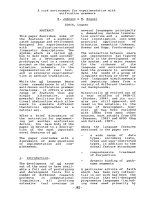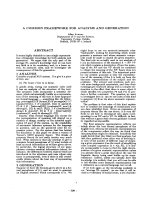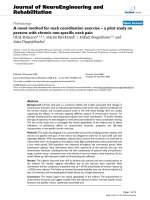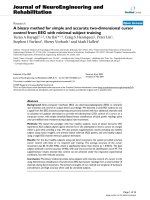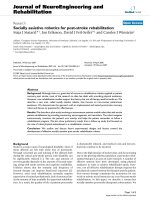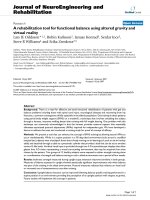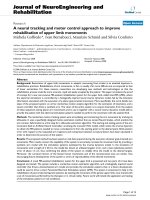Báo cáo hóa học: " A Facile Strategy for In Situ Core-Template-Functionalizing Siliceous Hollow Nanospheres for Guest Species Entrapment" potx
Bạn đang xem bản rút gọn của tài liệu. Xem và tải ngay bản đầy đủ của tài liệu tại đây (369.41 KB, 7 trang )
NANO EXPRESS
A Facile Strategy for In Situ Core-Template-Functionalizing
Siliceous Hollow Nanospheres for Guest Species Entrapment
Jun Wang Æ Xin Gao Æ Xianyan Yang Æ Yilai Gan Æ
Wenjian Weng Æ Zhongru Gou
Received: 9 February 2009 / Accepted: 15 June 2009 / Published online: 27 June 2009
Ó to the authors 2009
Abstract The shell wall-functionalized siliceous hollow
nanospheres (SHNs) with functional molecules represent
an important class of nanocarriers for a rich range of
potential applications. Herein, a self-templated approach
has been developed for the synthesis of in situ function-
alized SHNs, in which the biocompatible long-chain
polycarboxylates (i.e., polyacrylate, polyaspartate, gelatin)
provide the framework for silica precursor deposition by
simply controlling chain conformation with divalent metal
ions (i.e., Ca
2?
,Sr
2?
), without the intervention of any
external templates. Metal ions play crucial roles in the
formation of organic vesicle templates by modulating the
long chains of polymers and preventing them from sepa-
ration by washing process. We also show that, by in situ
functionalizing the shell wall of SHNs, it is capable of
entrapping nearly an eightfold quantity of vitamin Bc in
comparison to the bare bulk silica nanospheres. These
results confirm the feasibility of guest species entrapment
in the functionalized shell wall, and SHNs are effective
carriers of guest (bio-)molecules potentially for a variety
of biomedical applications. By rationally choosing the
functional (self-templating) molecules, this concept may
represent a general strategy for the production of func-
tionalized silica hollow structures.
Keywords Self-template Á In situ functionalizing shell
wall Á Guest molecule entrapment Á Siliceous hollow
nanospheres
Introduction
Inorganic hollow or porous micro-/nanostructures are of
great interest in many current and emerging areas of
technology partly because of their hollow or porous
chamber, high specific surface area, low toxicity and low
effective density [1–4]. Such hollow or porous capsules can
pave the way for industrial, environmental, biomedical and
biotechnological applications such as catalysis, separation,
delivery, immobilization and so on [5–8]. Recently, the
number of biologically active proteins, drugs and antimi-
crobials used to treat/prevent disease is growing rapidly,
but appropriate inorganic carriers for introduction of these
therapeutics into body are often lacking [9–11]. Silica
nanoparticles (i.e., bulk, hollow and porous structure) are
nontoxic, bioresorbable matrix as versatile carriers and
polishing component of toothpastes primarily due to the
fine thermal stability and chemical inertia [12–18]. In
particular, biomedical and biotechnological applications
with siliceous hollow nanospheres (SHNs) are currently
focused on guest (bio-)molecules delivery and controlled
release. Basically, these applications require the function-
alized shell wall with biocompatible functional molecules
to effectively improve the loading density of guest species,
which would also endow them with diverse properties.
Among the various hollow particles production techniques,
the template route has been investigated most extensively
due to its flexibility in controlling the particles size from
micrometer- to nanometer scales [19, 20]. Although the
classical sol–gel processes result in SHNs by using the
J. Wang Á X. Gao Á X. Yang Á Y. Gan Á Z. Gou (&)
Zhejiang California International NanoSystems Institute,
Zhejiang University, Huajiachi Campus, 310029 Hangzhou,
China
e-mail:
W. Weng
Department of Materials Science and Engineering, Zhejiang
University, Yuquan Campus, 310027 Hangzhou, China
123
Nanoscale Res Lett (2009) 4:1171–1177
DOI 10.1007/s11671-009-9378-7
core-template of micelles and rigid particles [12, 19–21],
the synthetic procedures are multistep and complex, and
the SHNs have significant shortcomings that limit their
functionality in the silica shell as sacrificing templates by
either calcination or chemical dissolution. So far, several
efforts have been directed toward the structural organiza-
tion of organic–inorganic hybrid SHNs via the catalytic
activity of polymers or vesicle template, but they suffer
from potential biocompatibility and ill-defined morphology
problems [22–25]. Thus, it is highly desired to develop
facile synthesis pathway for SHNs formation with shell
wall functionalization for biomedical applications.
The DNA conformational changes, such as nanoscale
toroid, spheroid and rodlike structure, modulated by mul-
tivalent cations (MVCs) have been widely appreciated as
superb model system for understanding gene packing in
biological systems [26–28]. This process prompts a number
of analogous studies on coils conformation and inorganic
superstructure formation by templating of ions-initiating
semiflexible polyelectrolyte polymers [29–34]. Particu-
larly, recent studies of DNA template synthesis have also
revealed that the ‘cationic’ plasmid DNA form can act as
an attractive template for the formation of ordered circular
and rodlike silica nanostructures [35]. We hypothesize that
the metal ions (for example, alkaline earth metals) are able
to crosslink long-chain polyanionic molecules to form
specific morphology with more complexity in comparison
with DNA toroid. Thus, a new strategy for constructing a
spherical complex (for example, vesicle) using a wide
range of polymers for templating SHNs formation has been
awaited.
On the basis of these considerations, we have developed
a one-step synthesis of biologically friendly SHNs
with functionalized hollow chamber from polymers self-
templated pathway, thanks only to electrostatic interaction
between polycarboxylates and divalent metal ions. The
SHNs are synthesized by a sonochemically assisted wet
chemical reaction, and metal ions are used as polymer
conformation modulators, without the intervention of any
external templates and potentially toxic surfactants or
mediums. Specifically, polyacrylate, polyaspartate and
alkaline-processed gelatin molecules containing COO
-
groups are initially selected because of their biocompatible
and noninflammatory nature, and especially because of
their reversible conformation changes with small external
pH changes [33, 36, 37]. To our knowledge, this is the first
report on the mild synthesis of hollow spheres composed of
silica shell wall, which is simultaneously (in situ) func-
tionalized by templating biocompatible polymers under the
modulation of biologically essential metal ions in aqueous
medium.
Experimental
Materials and Reagents
All chemicals used were commercially available. Reagents
used for the synthesis of hollow silica nanospheres inclu-
ded tetraethoxysilane (TEOS), absolute ethanol (99.7%),
calcium nitrate (Ca(NO
3
)
2
Á4H
2
O, 99.5%), strontium nitrate
(Sr(NO
3
)
2
Á4H
2
O, 99.5%), aqueous ammonia (28 wt%)
were purchased from Shanghai Chemical Reagent Co.
(SCRC, China) and used as received. The polyacrylate
sodium (30 wt%, average M
w
*2.5 KDa) (abbreviated as
PAS2.5) and poly(aspartic acid) (30 wt%, average M
w
*5.0 KDa) (abbreviated as PAsp5), gelatin (alkalic-pro-
cessing; 10 wt%, average M
w
*75 KDa) were obtained
from SCRC. Deionized distilled water (DDW) was used
throughout the experiment.
Synthesis of Siliceous Hollow Nanospheres
In a typical procedure, for instance of experiment No. 1
as mentioned in Table. 1, 1.0 ml of PA (30 wt%, M
w
2.5 KDa, denoted as PA2.5), 0.5 ml of Ca(NO
3
)
2
solution
(0.5 M) and 2.2 ml of ammonia (28%) were added to
26.2 ml of DDW and magnetically stirred for 10 min,
after which 20 ml of ethanol (99.7%) was added
sequentially to the aqueous solution and stirred for 5 min.
The resulting solution was subsequently added into a
200-ml three-necked flask with a mechanical stirrer, in a
water bath of ultrasonic (US) generator (40 kHz, 80 W).
Then 1.6 ml of TEOS was added into 50 ml of ethanol
under stirring for 1 min to ensure complete mixing.
Immediately, the mixture was also added into the flask
under vigorous stirring and ultrasonicating. The white
powders obtained by three-repeated centrifugation/DDW-
wash cycles at scheduled time and dried in vacuum.
Similarly, the synthesis was taken by using Sr(NO
3
)
2
as
the dicationic inducer (The strontium ions is one of the
important biologically active trace elements). The similar
synthesis procedure was also taken as controls without
and with acoustic cavitation in the presence and absence
of divalent metal ions, as mentioned in Table. 1, No. 2
and 3. To understand the structure variation, more SHNs
were synthesized by only changing the PAsp5 or gelatin
template under the same initial pH condition (Table. 1,
No. 4 and 5). In addition, the so-called pure bare bulk
silica nanospheres with solid-core were also prepared in
the absence of both organic additives and metal ions,
while the other reaction conditions remained the same
(Table. 1, No. 6).
1172 Nanoscale Res Lett (2009) 4:1171–1177
123
Examination of the As-Synthesized SHNs as a Carrier
of Biomolecules
The 0.8 wt% Vitamin Bc (denoted as VB, KCl solution,
pH = 10.5) and the freshly as-synthesized SHNs were
mixed in a suspension with the weight ratio of VB/
SHNs = 1/2, which was stirred vigorously for 8 h. After
rinsed with KCl solution (pH = 10.5) to remove the un-
entrapped molecules, the powders with the entrapped VB
dried in vacuum. As a comparison of the test on entrapment
efficiency, the experiment of bare bulk silica nanospheres
(100 nm or less in diamater) entrapping VB was taken as
control.
Characterization
The dried powders were determined by X-ray diffraction
(XRD, Rigaku D/max-rA) with Cu Ka radiation at a
scanning rate of 0.01°/min and Fourier transform Infrared
(FTIR, Nicolet) for the phase composition. The morphol-
ogy and chemical composition of the particles were
determined by transmission electron microscopy (TEM,
JEOL JEM-2010) connected with energy-dispersive X-ray
analysis (EDX, INCA EDAX, element [ B) operating at
200 kV. The scanning electric microscopy (SEM) images
were taken on a JEOL JEM-6700F microscope. Samples
were deposited onto quartz slides. Thermo-gravimteric
analysis (TGA) was performed using a TG/DTA6200, with
heating rate of 10 °C min
-1
in air. All the samples were
washed with DDW and dried to remove the physicosorbed
polymers prior to analysis.
Results and Discussion
We hypothesize that divalent metal ions (i.e., alkaline earth
metals) crosslink long-chain polymers to form vesicle-like
geometry, similar to DNA toroid under the mediation of
multivalent cation. The synthesis conditions for the sili-
ceous nanoparticles can be seen from Table 1. The trans-
mission electron microscopy (TEM) and scanning electron
microscopy (SEM) images in Fig. 1a and b show that when
Table 1 Synthesis details and conditions for the preparation of silica nanospheres
Series Polymer
a
Divalent metal ion Ultrasonication
b
Ageing time (min) Microstructure
c
No. 1 PA2.5 Ca or Sr US 5, 12, 20 Hollow
No. 2 PA2.5 Ca or Sr No US 20 Hollow and bulk
No. 3 PA2.5 - US 20 Bulk
No. 4 PAsp5 Ca or Sr US 20 Hollow
No. 5 Gelatin Ca or Sr US 20 Hollow
No. 6 No US 20 Bulk
a
PA2.5: M
w
ca. 2.5 KDa, 30 wt%; Getalin: M
w
ca. 75 KDa, 10 wt%; PAsp5: M
w
5.0 KDa, 30 wt%
b
The reactions with and without the assistance of ultrasonication (US) condition were denoted as US and no US, respectively
c
The microstructures of silica particles were characterized by using transmission electron microscopy
Fig. 1 TEM and SEM images
of SHNs mediated by PA2.5
with (a–c) and without (d)
cavitation, PAsp5 with
cavitation (e), gelatin with
cavitation (f)
Nanoscale Res Lett (2009) 4:1171–1177 1173
123
PA2.5 and Ca
2?
ions were used as structural templates
(No. 1, Table. 1), the particles exhibit hollow interiors,
spherical particle morphology, small opens and nanometer-
scale dimension. The diameters of the SHNs are approxi-
mately 200 nm or less. The shell wall growth process was
monitored by TEM. TEM imaging of the shell wall is
shown Fig. 1c, which contains representative images. As
expected, the shell thickness (4–20 nm), estimated by high
magnification images from ring around the perimeter of
hollow structure, could be precisely tailored through pro-
longing the reaction time (5–20 min), suggesting that the
silica precursors continuously deposit onto the shell wall
surface. Another prominent feature of the SHNs is that
there are several open holes in the shell walls (Fig. 1b).
These porous structures with openings of over 10 nm in
diameter, larger than the mesoporous cavities of silica
particles, are enough to accommodate the guest macro-
molecules, and thus tend to be much easily immobilized
and released, without destructing the chamber of the SHNs
[38]. This is likely due to the durative cavitation stimuli so
that small openings are necessary to maintain the pressure
balance between the inside and outside of shell walls.
Furthermore, this unique method using the other polycar-
boxylate and divalent metal ions mixtures as templates can
be extended to synthesize similar hollow nanoparticles.
Figure 1e and f illustrates the resulting SHNs with a rather
uniform diameter and shell thickness through using the
PAsp5 and gelatin as core templates (No. 4 and 5, Table 1).
It is worth noting that a control experiment (No. 2, Table 1)
without sonication did show the evidence of hollow
nanostructure, though a few bulk particles were observed
(Fig. 1d). However, the similar suspension in the presence
of polymers but in the absence of metal ions (No. 3,
Table 1), yielded bulk silica nanoparticles, which is almost
the same as that harvested from the conventional sto
¨
ber
method (No. 6, Table 1). It is clear that the structure-
directing metal ions induce the formation of vesicle in this
process, which is partly supported by the experimental
results of Schweins et al. [31] and Go
¨
ransson et al. [32] that
a long-chain polymer and oppositely charged surfactant/
ions mixture solution with different mole ratios induce the
formation of vesicles in a sufficiently diluted NaBr or NaCl
solution. Therefore, the diverse experimental results clearly
suggest the long-chain polycarboxylate templates mediated
by divalent metal ions in the silica precursor aqueous
medium enable the production of siliceous hollow shell
morphology.
Figure 2 shows the EDX spectrum that revealed that the
SHNs were indeed composed of silica (Si, 71.99 wt%),
metal ion (Ca, 0.30 wt%) and polymers (C, 3.12 wt%).
However, it is difficult to determine the accurate content of
polymers on the basis of the EDX spectrum, since element
C from carbon film supported on the copper grid has been
included. Additionally, X-ray diffraction (XRD) measure-
ment shows the grown peaks in the silica region at *22°–
26°/2h with progression in the deposition and maturation
process (from 5 to 20 min). The amorphous nature was
confirmed by the diffused wide patterns from the XRD data
(inset, Fig. 2).
It also highlighted the importance of the shell wall
modification to entrap guest molecules. Fourier-transformed
infrared (FTIR) spectra are shown in Fig. 3. As expected, the
absorption bands at 1,660–1,400 cm
-1
corresponding to the
amide I (C=O/C–N stretch) and II (N–H bend/C–H stretch)
of PAsp5 or carboxylic group (C=O stretch) of PA2.5 were
observed. However, this is different to the bare hollow silica
free from the organic additives synthesized in a W/O/W
emulsion system [39]. This suggests that the metal ions act as
Fig. 2 EDX spectrum of SHNs synthesized by using PA2.5 and
calcium ions with a 20 min of ageing time. The sample was
thoroughly washed with DDW at 37 °C to remove the organic
molecules physicosorbed on the surface of hollow spheres prior to
analysis. In the inset XRD patterns of SHNs exhibiting different
intensities at 22°–26°/2h with the prolongation of ageing time are
displayed
Fig. 3 FTIR spectra (solid lines) of the SHNs synthesized in the
presence of PA2.5 (a) and PAsp5 (b), respectively. The dot lines
represent the FTIR spectra of pure PA2.5 and PAsp5, respectively
1174 Nanoscale Res Lett (2009) 4:1171–1177
123
bond bridges between functional molecules and silanol
groups so that the polymers exhibit very well washing-
resistant ability, in comparison to the compact aggregated
polymer templates sensitive to washing process [14]. Evi-
dently, the polymer spherical geometry (just as ‘‘soft’’ tem-
plate) substantially represents a fundamental morphology
selected by the spatial charge stability in solution, which is
similar to the observed DNA toroidal compaction, but dis-
tinct from the polymer-silica hybrid films or spheres under
slightly acidic condition [40, 41]. Furthermore, although the
structure-directing metal ions are readily attached on the
surface of the polymer vesicles through electrostatic inter-
action with side carboxylic groups, the excessive dications
possibly reside within the silica shell/medium interfacial
region and contribute to a decrease in electrical double layer,
avoiding silica nucleation in the suspension. Throughout the
experiment, the structure of the vesicles does not collapse
during the sol–gel process of silica sources, which result in
the silica shell completely replicating the vesicle’s structure,
and the shell thickness increase rapidly.
Another important point, however, that has not been
studied in previous reports is the loading capability for
guest species of the SHNs obtained after washing process.
In order to determine whether guest molecules can be
entrapped by the shell chambers of the as-synthesized
SHNs, in vitro adsorption experiments were conducted.
Specifically, the measure of entrapment efficacy was
obtained by using Vitamin Bc (VB) as model molecule and
verified by TGA (Fig. 4). VB, folic acid, and other names
of the same chemical, long believed to be of great
medicinal benefit, is composed of a pteridine nucleus, a
pteroyl portion and glutamic acid and is coenzyme
involved in transfer and utilization in a variety of essential
physiological reactions, including amino acid metabolism,
biosynthesis of DNA and RNA and prominent antitumor
activity [42, 43]. By contrast with the bulk silica (curve a),
the added weight loss between 250 and 600 ° C of 4.9 and
5.7% under the background level of curve b corresponded
to thermolysis of PA2.5 (curve c) and PAsp5 (curve d),
respectively. More interestingly, a clear distinction
between bulk and hollow spheres afterward internalizing
VB could be measured by TGA. The weight loss increased
drastically (*6.5%) after entrapping VB (compare curve d
with e), which was predominantly associated with the
thermolysis of VB. In contrast, the weight loss of bulk
silica changed little (\0.8%) before and after entrapping
VB (compare curve a with b), implying a strong depen-
dence of the trapping efficiency of gust molecules on sur-
face functionality. It should be noted, however, that since
VB internalized in hollow chamber were more difficult to
volatilize than those adsorbed on the bulk silica surface, the
volatilization of VB underwent a wide temperature range.
There is more than an eightfold obvious increase in the
VB-entrapped quantity versus those on the bare bulk silica
nanospheres. This increase is attributed to caging effects
that isolate VB from the aqueous medium and from specific
strong interactions. This is possibly helpful to develop new
bioactive molecule delivery system for therapeutic and
antimicrobial applications.
More recently, other authors have also reported that
block copolymer micelle initialized in chloroform, besides
the cationic DNA circular or coiled-coil structures [35], can
act as morphologically changeable templates for hollow
silica spheres or tubules formation [44]. Indeed, we agree
when these aggregated polymer micelle is viewed as tem-
plate for SHNs, in which the terminal amide groups instead
of the cationized side groups is the anchor point for silica
nucleation. In the present study, we find significant dif-
ferentiation from the polymer templates in the presence and
absence of metal ions, however (for example, those shown
in Table.1, No. 1 and No. 3). This phenomenon is evidently
deviated from the existing aggregated polymer-templating
synthesis with and without the assistance of sonication
[
14, 15].
A proposed mechanism is displayed in Scheme 1
showing the electrostatic interaction between organic
molecules and metal ions and subsequently similar inter-
action between metal ions and silanol groups of silica
precursor. Generally, the long-chain polycarboxylate with
a large quantity of electron-donating side groups (COO
-
groups) itself is expanded by electric repulsion according
to the dissociation of the ionic groups in a dilute basic
solution [45] (Scheme 1 a, b). When the dications (i.e.,
Ca
2?
,Sr
2?
) are added into the solution, the carboxylic side
groups of the polymers interact electrostatically or chelate
Fig. 4 Thermogravimeteric analysis (TGA) of the SHNs and bulk
silica nanoparticles before and after entrapping VB. a bulk Silica
nanoparticles, b VB-entrapped bulk silica nanoparticles, c SHNs
synthesized in the presence of PA2.5, d SHNs synthesized in the
presence of PAsp5, e VB-entrapped SHNs
Nanoscale Res Lett (2009) 4:1171–1177 1175
123
with the dications. Then, the main-chains of the polymers
bend and pack into a spherical vesicle-like geometry with
an appropriate size of *100 nm in diameter under the
assistance of sonication (Scheme 1b, c). Accordingly, the
side carboxylic chains anchored with metal ions may be
favorable for interacting with the negatively charged silica
precursors (Scheme 1c, d), and well-defined spherical
morphology of silica shell architectures produced on the
polymer vesicle.
In addition, our many check and reproducible experi-
ments, for example the ‘‘cationic’’ polyepoxysuccinate
vesicles, validated the SHNs production while the other
reaction conditions remained the same (data not shown). It
is obvious that the side-chain complexity of polyacrylate,
polyaspartate and gelatin is increased progressively. The
alkalic-processed gelatin, formed from denatured and
degraded collagen, has a poorly defined structure, but the
portions of collagen molecules with characteristic triple
helical structure are still present and lie in parallel layers.
Thus, this molecule possesses a great proportion of car-
boxyl groups, rending it negatively charged and expanding
in the alkaline aqueous solution.
Conclusions
In summary, we have developed a more facile and versatile
method to obtain highly functionalized HSNs with open-
ings. The shell wall thickness of the hollow spheres can be
easily tailored by varying the aging time, and the particle
size can be controlled below submicron dimension. This
method is based on the in situ adsorption of functional
molecules in the hollow chamber of hollow spheres in an
aqueous medium, without involving additional template
and hazardous additives. The participation of electrostatic
interactions between a diversity of carboxylic groups-rich
long-chain polymers and divalent metal ions was evi-
denced. Extension of the present versatile technique to
other functional polymers may enable the preparation of
siliceous hollow carriers with different functionalities.
These materials with high functionalized shell wall could
be good candidates for guest molecules adsorption, which
is particularly useful in the biomolecules delivery for
therapy and antimicrobial agent release for preventing
caries.
Acknowledgments The authors would like to acknowledge finan-
cial support by the FSTDZP (2008C21058), CFZUWST (H20080039)
and ZCNI (J30802).
References
1. D.L. Wilcox, M. Berg, T. Bernat, D. Kellerman, J.K. Cochran
(Eds.), Hollow and Solid Spheres ans Microspheres. MRS sym-
posium Proceedings. Vol. 372 Materials Research Society,
Pittsburg, PA, 1995
2. K.K. Perkin, J.L. Tuner, K.L. Wooley, S. Mann, Nano. Lett. 5,
1457 (2005)
3. Y. Cai, H. Pan, X. Xu, Q. Hu, L. Li, R. Tang, Chem. Mater. 19,
3081 (2006)
4. A.M. Collins, C. Spickermann, S. Mann, J. Chem. Mater. 13,
1112 (2003)
5. M. Lal, L. Levy, K.S. Kim, G.S. He, X. Wang, Y.H. Min, S.
Pakatchi, P.N. Prasad, Chem. Mater. 12, 2632 (2000)
6. K. Sharma, S. Das, A. Maitra, J. Colloid Interface Sci. 284, 358
(2005)
7. X. Tan, S. Li, J. Membr. Sci. 188, 87 (2001)
8. J.J.E. Lee, J. Lee, J.H. Yu, B.C. Kim, K. An, Y. Hwang, C.H.
Shin, J.G. Park, J. Kim, J. Am. Chem. Soc. 128, 688 (2006)
9. R. Langer, Nature 392, 5 (1998)
10. X.W. Lou, L.A. Archer, Z. Yang, Adv. Mater. 20, 1 (2008)
11. Y. Piao, A. Burns, J. Kim, U. Wiesner, T. Hyeon, Adv. Funct.
Mater. 18, 1 (2008)
12. C. Barbe
´
, J. Bartlett, L. Kong, K. Finnie, H.Q. Lin, M. Larkin, S.
Calleja, A. Bush, G. Calleja, Adv. Mater. 16, 1959 (2004)
13. G. Caturan, R.D. Toso, S. Boninsegna, R.D. Monte, J. Mater.
Chem. 14, 2087 (2004)
14. T. Shiomi, T. Tsunoda, A. Kawai, H. Chiku, F. Mizukami,
K. Sakaguchi, Chem. Commun.5325(2005). doi: 10.1039/b507736b
15. Y. Wan, S H. Yu, J. Phys. Chem. C 112, 3641 (2008)
16. W. Fan, L. Zhao, J. Colloid Interface Sci. 297, 157 (2006)
17. D.J. Bharali, I. Klejbor, E.K. Stachowiak, P. Dutta, I. Roy,
N. Kaur, E.J. Bergey, P.N. Prasad, M.K. Stachowiak, PNAS 102,
11539 (2005)
Scheme 1 Schematic representation of the long-chain polymer vesicular self-templating SHNs formation, and in situ functionalized with
biocompatible polymer, rich in side carboxylic acid
1176 Nanoscale Res Lett (2009) 4:1171–1177
123
18. R.M. Gaikward, I. Sokolov, J. Dent. Res. 87, 980 (2008)
19. F. Caruso, R.A. Caruso, H. Mhwald, Science 282, 111 (1998)
20. M. Chen, L. Wu, S. Zhou, B. You, Adv. Mater. 18, 801 (2006)
21. Y.J. Wang, F. Caruso, Chem. Mater. 17, 953 (2005)
22. K.J.C. van Bommel, J.H. Jung, S. Shinkai, Adv. Mater. 13, 1472
(2001)
23. J.F. Chen, H.M. Ding, J.X. Wang, L. Shao, Biomaterials 25, 723
(2004)
24. D. Ma, M. Li, A.J. Patil, S. Mann, Adv. Mater. 16, 1838 (2004)
25. D.H.W. Hubert, M. Jung, P.M. Frederik, P.H.H. Bomans, J.
Meuldijk, A.L. German, Adv. Mater. 12, 1286 (2000)
26. N.V. Hud, I.D. Vilfan, Annu. Biophys. Biomol. Struct. 34, 295
(2005)
27. W.M. Gelbart, R.F. Bruinsma, P.A. Pincus, V.A. Parsegian, Phys.
Today 53, 38 (2000)
28. N.V. Hud, K.H. Downing, PNAS 98, 14925 (2001)
29. A. Tsortos, G. Nancollas, J. Colloid Interface Sci. 250, 159
(2002)
30. F. Molnar, J. Rieger, Langmuir 21, 786 (2005)
31. R. Schweins, P. Lindner, K. Huber, Macromolecules 36, 9564
(2003)
32. A. Go
¨
ransson, P. Hansson, J. Phys. Chem. B 107, 9203 (2003)
33. B. Fiers, T. Kiefhaber, J. Am. Chem. Soc. 129, 672 (2007)
34. K. Huber, T. Witte, J. Hollmann, S. Keuker-Baumann, J. Am.
Chem. Soc. 129, 1089 (2007)
35. M. Numata, K. Sugiyasu, T. Hasegawa, S. Shinkai, Angew.
Chem. Int. Ed. 43, 3279 (2004)
36. Y. Zhang, M. Jiang, J. Zhao, Z. Wang, H. Dou, D. Chen,
Langmuir 21, 1531 (2005)
37. G. Tama
´
s, T. Vikto
´
ria, G. Benja
´
min, Z. Miklo
´
s, Acta Biomater.
4, 733 (2008)
38. M. Fujiwara, K. Shiokawa, K. Hayashi, K. Morigaki, Y. Naka-
hara, J. Biomed. Mater. Res. Part A 81A, 103 (2007)
39. M. Fujiwara, K. Shiokawa, I. Sakakura, Y. Nakahara, Nano. Lett.
6, 2925 (2006)
40. R. Mouawia, A. Mehdi, C. Reye
´
, R. Corriu, J. Mater. Chem. 17,
616 (2007)
41. M. Khiterer, K.J. Shea, Nano. Lett. 7, 2684 (2007)
42. R.T.P. Paul, A.P. McDonnell, C.B. Kelly, Hum. Psychopharma-
col. Clin. Exp. 19, 477 (2004)
43. S.D. Weitman, R.H. Lark, L.R. Coney, D.W. Fort, V. Frasca,
V.R. Zurawski Jr., B.A. Kamen, Cancer Res. 52, 3396 (1992)
44. H. Lee, K. Char, Appl. Mater. Interfaces 1, 913 (2009)
45. C. De
´
jugnat, G.B. Sukhorukov, Langmuir 20, 7265 (2004)
Nanoscale Res Lett (2009) 4:1171–1177 1177
123

